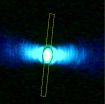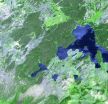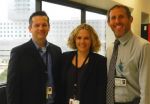EARTH Magazine: How much natural hazard mitigation is enough?
2014-11-17
(Press-News.org) Alexandria, Va. -- Hurricane Sandy struck the U.S. East Coast in October 2012, leaving about $65 billion of damage in its wake and raising the question of how to mitigate the damage from future storms. It's a question that arises in the wake of most natural disasters: What steps can society take to protect itself from storms, floods, landslides, earthquakes, tsunamis or volcanic eruptions? But the question itself illustrates the complexity of preparing for natural disasters.
Our first instincts might be to protect ourselves as well as possible, but reality sets in quickly: Society has finite resources. Resources used to mitigate potential hazards are not available for other purposes. For example, funding higher levees to reduce flooding competes with plans to improve highways. And money spent making school buildings earthquake-resistant cannot be used to hire teachers. Communities thus face the fundamental question of deciding how much mitigation is enough.
Prioritizing is always hard, but it is especially difficult for natural hazards, because of the scientific inability to forecast the future. But prioritizing is not impossible, says Seth Stein, author of "Playing Against Nature: Integrating Science and Economics to Mitigate Natural Hazards in an Uncertain World" and the Deering Professor of Geological Sciences at Northwestern University. Formulating natural hazard policy should involve combining science and economics to analyze a problem and explore different options, recognizing that the future is uncertain. Read more about the ways to figure out the optimal amount of mitigation in the December issue of EARTH magazine: http://bit.ly/1xxyj1J.
INFORMATION:
For more stories about the science of our planet, check out EARTH magazine online or subscribe at http://www.earthmagazine.org. The December issue, now available on the digital newsstand, features stories on a huge set of dinosaur tracks found in Alaska, hundreds of methane seeps found along the U.S. East Coast, and snow triggering earthquakes on Mount Rainier, plus much, much more. Be sure not to miss the year-end musings of EARTH staff and contributors as well!
Keep up to date with the latest happenings in Earth, energy and environment news with EARTH magazine online at: http://www.earthmagazine.org/. Published by the American Geosciences Institute, EARTH is your source for the science behind the headlines.
The American Geosciences Institute is a nonprofit federation of 49 geoscientific and professional associations that represents more than 250,000 geologists, geophysicists and other earth scientists. Founded in 1948, AGI provides information services to geoscientists, serves as a voice of shared interests in the profession, plays a major role in strengthening geoscience education, and strives to increase public awareness of the vital role the geosciences play in society's use of resources, resiliency to natural hazards, and interaction with the environment.
ELSE PRESS RELEASES FROM THIS DATE:
2014-11-17
CORVALLIS, Ore. - Engineers at Oregon State University have identified a method to rapidly prepare frozen red blood cells for transfusions, which may offer an important new way to manage the world's blood supply.
It's already possible to cryopreserve human red blood cells in the presence of 40 percent glycerol, but is rarely done because of the time-consuming process to thaw and remove the glycerol from the blood. This can take an hour or more and makes it logistically difficult to use frozen blood.
However, some initial experiments and computer modeling of a proposed ...
2014-11-17
RENO, Nev. - The everyday use of a GPS device might be to find your way around town or even navigate a hiking trail, but for two physicists, the Global Positioning System might be a tool in directly detecting and measuring dark matter, so far an elusive but ubiquitous form of matter responsible for the formation of galaxies.
Andrei Derevianko, of the University of Nevada, Reno, and his colleague Maxim Pospelov, of the University of Victoria and the Perimeter Institute for Theoretical Physics in Canada, have proposed a method for a dark-matter search with GPS satellites ...
2014-11-17
LIVERMORE, Calif. - Lawrence Livermore National Laboratory researchers have developed an efficient method to measure residual stress in metal parts produced by powder-bed fusion additive manufacturing.
This 3D printing process produces metal parts layer by layer using a high-energy laser beam to fuse metal powder particles. When each layer is complete, the build platform moves downward by the thickness of one layer, and a new powder layer is spread on the previous layer.
While this process is able to produce quality parts and components, residual stress is a major ...
2014-11-17
The race to make computer components smaller and faster and use less power is pushing the limits of the properties of electrons in a material. Photonic systems could eventually replace electronic ones, but the fundamentals of computation, mixing two inputs into a single output, currently require too much space and power when done with light.
Researchers at the University of Pennsylvania have engineered a nanowire system that could pave the way for this ability, combining two light waves to produce a third with a different frequency and using an optical cavity to amplify ...
2014-11-17
Rice University scientists have invented a novel cathode that may make cheap, flexible dye-sensitized solar cells practical.
The Rice lab of materials scientist Jun Lou created the new cathode, one of the two electrodes in batteries, from nanotubes that are seamlessly bonded to graphene and replaces the expensive and brittle platinum-based materials often used in earlier versions.
The discovery was reported online in the Royal Society of Chemistry's Journal of Materials Chemistry A.
Dye-sensitized solar cells have been in development since 1988 and have been the subject ...
2014-11-17
Scientists using a microbe that occurs naturally in eastern cottonwood trees have boosted the ability of two other plants - willow and lawn grass - to withstand the withering effects of the nasty industrial pollutant phenanthrene and take up 25 to 40 percent more of the pollutant than untreated plants.
The approach could avoid the regulatory hurdles imposed on transgenic plants - plants with genes inserted from or exchanged with other plant or animal species - that have shown promise in phytoremediation, the process of using plants to remove toxins from contaminated sites, ...
2014-11-17
More than a decade ago, researchers from Brigham and Women's Hospital (BWH) demonstrated that a high dose statin, which lowered cholesterol further than a regular dose statin, provided better clinical outcomes. But questions remained about whether further reducing cholesterol would be even more effective in reducing cardiovascular-related events.
Now, results of the highly anticipated IMProved Reduction of Outcomes: Vytorin Efficacy International Trial (IMPROVE-IT), co-led by researchers at BWH and Duke Medicine, indicate that adding a second drug, ezetimibe, that blocks ...
2014-11-17
WCS, NASA, And other conservation and remote sensing agencies, universities and NGOs focus on top 10 conservation questions for satellite technology
Remote sensing has and can continue to play a critical role in conserving Earth's biological diversity
Protected area management is a key use of remote sensing data
Newly formed Conservation Remote Sensing Network to apply remote sensing data to conservation challenges
NEW YORK (November 17, 2014)--Scientists from the WCS (Wildlife Conservation Society), NASA, and other organizations have partnered to focus global attention ...
2014-11-17
Harvard Stem Cell Institute (HSCI) researchers, representing five Harvard departments and affiliated institutions as well as the Massachusetts Institute of Technology (MIT), have demonstrated that adult cells, reprogrammed into another cell type in a living animal, can remain functional over a long period.
The work by Joe Zhou, an associate professor in Harvard's Department of Stem Cell and Regenerative Biology, and his collaborators is an important advance in the effort to develop cell-based therapies for tissue repair, and specifically in the effort to develop improved ...
2014-11-17
HOUSTON - (Nov. 17, 2014) - Offering small financial incentives doubles smoking cessation rates among socioeconomically disadvantaged smokers, according to research from The University of Texas Health Science Center at Houston (UTHealth). The findings were published last week in the American Journal of Public Health.
Tobacco use is the leading cause of preventable death in the United States, according to the Centers for Disease Control and Prevention. Thanks to public health efforts, smoking rates have declined to 18 percent among American adults. However, nearly 30 percent ...
LAST 30 PRESS RELEASES:
[Press-News.org] EARTH Magazine: How much natural hazard mitigation is enough?





